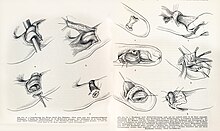Sauerbruch arm
The Sauerbruch arm was one of the surgeon Ferdinand Sauerbruch designed prosthesis , mainly for maimed veterans of the First World War was intended. However, only a few affected people could afford the high costs of the prosthesis, so that its use was limited from the outset. For this purpose, a skin-lined canal was placed through the muscle tissue of the remaining stump of the arm, through which a bolt was inserted. This enabled the movement of the remaining muscles in the arm stump to be transferred to the prosthesis parts, especially the hand (the hip hand).

history
At the end of the First World War, Jakob Hüfner developed a mechanism for arm amputee soldiers that transferred muscle movements to the thumb and index finger and constructed a mechanical replacement hand. It could be actively opened and closed. In 1920 he registered his invention with the Reich Patent Office . Sauerbruch used Hüfner's two-pull hand. After 1945 this invention helped around 50,000 arm amputees to reintegrate into working life. One of the main locations for this surgical technique was the Caritas hospital for severely disabled victims operated by Max Lebsche in Fürstenried Castle / Munich. If the amputation situation permitted, patients who had lost both hands were not given two Sauerbruch prostheses if possible, but ideally an attempt was made to form a Krukenberg plastic on the left arm (for right-handed people) . This has a high gripping force and is a useful addition to the capabilities of the Sauerbruch arm.
The Sauerbruch prosthesis did not catch on because inflammations and infections often occurred in this canal. The idea of transferring the motor control to the prosthesis, however, was not discarded, but came up again with the myoelectric prosthesis . However, their distribution is limited because of their high price.
reception
The Sauerbruch arm found a literary echo in Bertolt Brecht's treatise Me-ti. Book of Twists . In this publication, a fictional figure based on Ferdinand Sauerbruch appears: the doctor Schin-fu, who worked in hospitals and became known for the construction of an artificial hand for soldiers.
Trivia
Contrary to sometimes rumored information, the Wehrmacht officer Claus Schenk Graf von Stauffenberg did not wear a Sauerbruch prosthesis.
literature
- Martin Friedrich Karpa: The history of the arm prosthesis with special consideration of the performance of Ferdinand Sauerbruch (1875–1951). Dissertation. Bochum 2005 ( online , PDF; 4.65 MB).
- Marion Maria Ruisinger (Ed.). The hatter's hand. German Medical History Museum , No. 40, Ingolstadt 2014.
- Marion Maria Ruisinger: Medical History 3 D. In: Bayrisches Ärzteblatt. 3/2014, p. 115.
Web links
- The arbitrarily movable artificial hand . (1937) in the virtual laboratory . Excerpt from theuniversity film producedunder Sauerbruch's direction for the Reich Office for the educational film
- "Jewelry arms" and "replacement links": prosthetics in the First World War
- The Hatter's Hand Exhibition in the Medical History Museum Ingolstadt
Individual evidence
- ^ Munich City Archives: Anniversary Operation. City of Munich, 2015, accessed on January 14, 2020 .
- ↑ Bertolt Brecht: Me-ti / book of turns. Work edition Volume 12 (Prose 2), Suhrkamp, Frankfurt am Main 1967, p. 501.
- ^ Ulrich Schlie: Claus Schenk Graf von Stauffenberg: Biography of Ulrich Schlie. Verlag Herder GmbH, accessed on January 14, 2020 .
